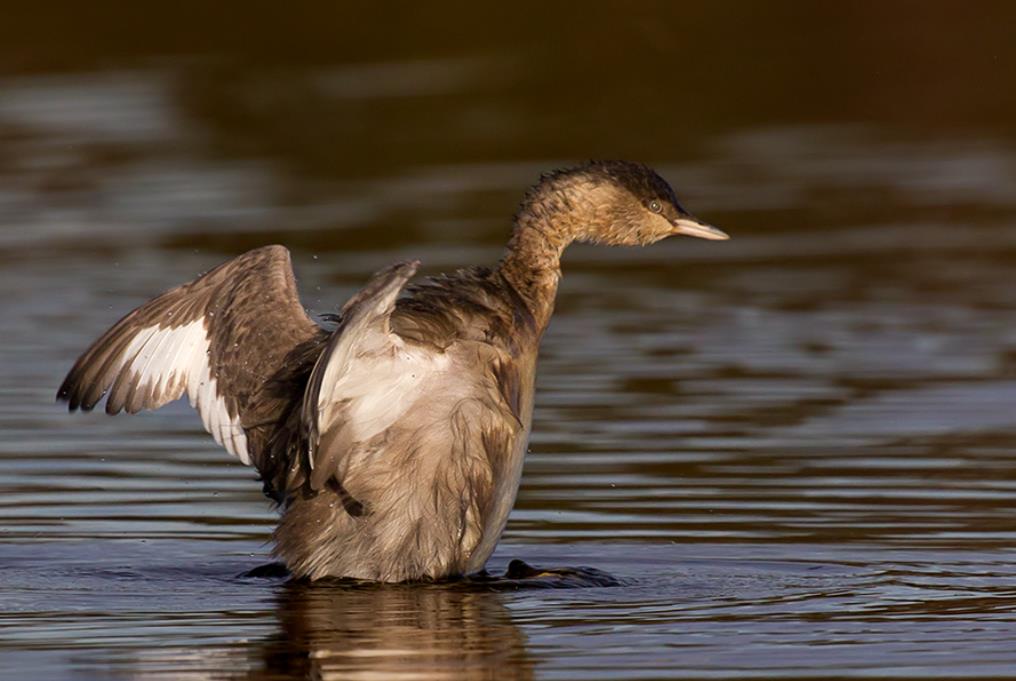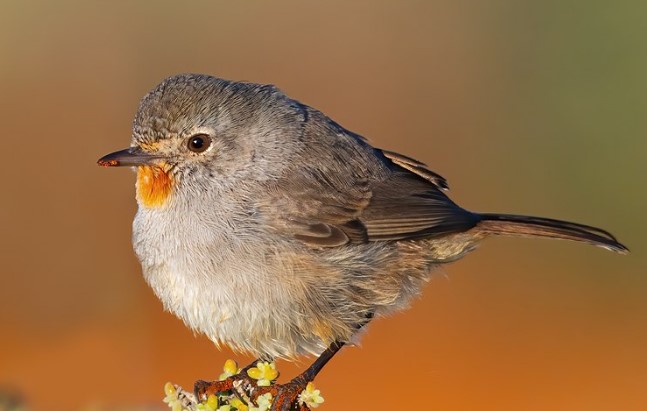The hoary-headed grebe (Poliocephalus poliocephalus) is an enchanting waterbird known for its distinctive appearance and captivating behaviors.
It is often spotted gliding gracefully across inland waters. Its hoary head feathers give it an almost supernatural look. Hoary-headed Grebes are predominantly diurnal, which means they are active during the daytime. They spend much time foraging, preening, and participating in social activities.
Behavior and Habitats: The hoary-headed grebe often sunbathes like other small grebes. It is a common bird in Australia, with a population of roughly 500,000. Its habitat is comparable to that of the Australasian grebe. Interestingly, it keeps its tail towards the sun, with feathers spread to allow the sun’s rays to heat the black skin of the bird’s back. The more heat birds receive from the sun, the less energy they require to generate metabolically through food. Hoary-headed Grebes are expert divers. They use their powerful legs and lobed feet to drive themselves underwater in search of food. Their pointed bill allows them to catch and digest their prey efficiently.
Hoary-headed Grebes frequently open unsheltered sheets of fresh or saline water. Adapted to the ephemeral nature of such waters inland, they are highly nomadic and often fly long distances at night despite their weak wings. They are also the most communal of all grebes. They habitually nest in groups, clustering on open water, and clumping in loose rafts to roost. Hoary-headed Grebe’s slender, streamlined body, allows for nimble swimming and diving. Hoary-headed Grebes play an important function in keeping ecosystems balanced. They help manage insect populations and improve the overall health of aquatic ecosystems.
Diet: Like other grebes, they dive for their prey, but in a stereotyped way that limits them to searching and gleaning for mainly stationary food—various aquatic insects, zooplankton, and occasional crustaceans. Pairing is impermanent, and courtship is simple, involving ceremonies both in the water and on the nesting platform where copulation takes place. This species feeds during the day and forages primarily near the water’s surface when there is little light.
Identification: Both sexes are similar. However, the male bird is somewhat larger and lunger-billed. Mid-grey above, white below; neck and upper breast pale buff. Crown and throat black with overlying narrow white plumes and gray face. Wings are gray-brown with a broad white band through the middle remiges.
The eyes are golden yellow (male) or ivory. (female) finely speckled with black. The bill is black with a pale tip. The feet and toes are dull olive. In the non-breeding season, the top of the head is plain dark grey. The throat and sides of the head are white. The bill is largely pale. The immature bird crown is marked with black, buff, and white spots and lines on the sides of the head. Eyes are brown. The downy young are not described.
Movements: Hoary-headed Grebe undertakes local movements in response to changing water levels and food availability. These local movements are not true migrations but are critical for their survival in fluctuating environments.
Vocalizations: It is usually a silent bird, but there are occasional soft guttural notes in flocks and copulation. Their vocal repertoire comprises a wide range of cries utilized for communication among mates and signaling during social encounters. These calls are critical to preserving group cohesion and coordinating activity.
Size: Hoary-headed Grebe size is about 270–300 mm in length. Its compressed size makes it perfectly adapted to its aquatic lifestyle.
Courtship: One remarkable characteristic of Hoary-headed Grebes is their elaborate mating displays. These displays include synchronized swimming and mutual preening, which improve the bond between mates.
Nesting: The nesting breeds occur in November-January or after rains; one brood per season. Nest floating, of algae and other water plants; sometimes in groups of up to 400 nests, or apart. These nests are built of plant material and meticulously designed to float on the water’s surface, providing a safe environment for eggs and chicks. In the suitable seasons, they coincide with an abundance of food and ideal nesting conditions.
Eggs and Incubation: The bird lays 2 to 6 eggs; chalky pale blue becoming stained with brown; ellipsoidal, about 40 x 28 mm. Both sexes share the roughly 20–24 day incubation period. Their coordinated effort ensures that the chicks have a greater survival rate.
Distribution: Hoary-headed Grebes are found in sheets of open fresh or saline water and reservoirs with ample aquatic vegetation throughout Australia, most numerous in the southeast and southwest. The bird was earlier endemic but now established in New Zealand. It is largely absent from Australia’s central arid regions.
Best Times to Watch Birds: As a bird watcher, if you are interested in seeing hoary-headed grebes, go to freshwater lakes and ponds during the breeding season in the spring and early summer. The best times to go birdwatching are early in the morning and late in the afternoon. To avoid disturbing birds, always observe them from a safe distance. To safeguard birds’ habitats, use binoculars or a digital camera and stick to the right trails.
Family: Podicipedidae
Races: There are no races
Status: Least Concern.
The hoary-headed grebe is a bird with distinct features and behaviors. Understanding and saving this species is critical to ensuring the health of aquatic ecosystems. By learning about their behavior, habitats, and conservation needs, we can help preserve them and ensure that future generations can see these lovely birds.
Read More: Acorn Woodpecker: A Social and Active Bird







